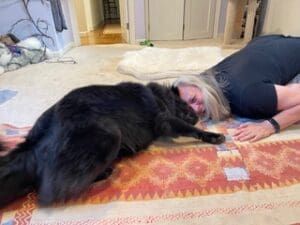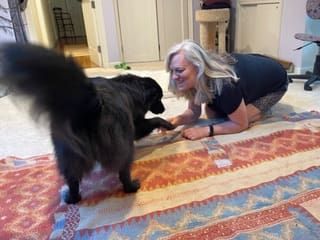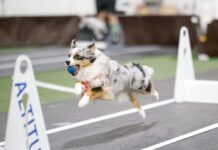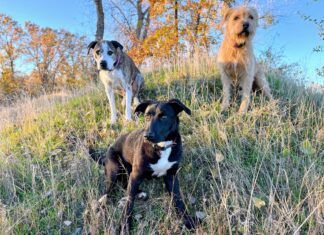Do you know how to truly play with your dog?
It sounds like a silly question, I know. But I’m dead serious, because a lot of caring dog owners actually don’t. Sure, they play fetch or tug, but that’s not what I’m talking about. What I love to encourage in a human-dog team is a less formal, goofier play connection—one that’s less top-down, less structured. I want to see a human on the living room floor with her dog, trading off gentle hip checks and soft head butts.
Why is this kind of play so important? What magic does this interaction have that fetch and tug don’t? For me, the answer is that our dogs spend most of their days having to work pretty hard just to navigate Planet Human. Imagine the relief as you signal to your dog that, for a few minutes, the two of you can just hang together, goofing around as pals.
Sometimes, I walk into a client’s home and see a dog who doesn’t quite know what’s up. She hangs back and hesitates. My strong impression is that she’s not sure what to make of where she’s landed or of these people she’s wound up with. That’s when I want to see if bringing some real play into their relationship might shift the dynamic, building confidence and connection.
Dogs Loosen Up, Reveal Another Side with True Play
A while back, I had a Zoom consult with a woman who was baffled by her rescue dog. They’d been together for months, but something felt off. She reported that the dog seemed “fine,” but just kind of sat around and stared at her a lot. Half a dozen theories were bouncing around in my brain when she mentioned that her dog sitter had little kids. I was bracing for a scary story about a bite when she added, “… and he just loved playing with them! I’ve never seen him act that way. He looked so happy.”
Ah ha! I asked her how she tended to act and move around the house:
- Do you work at your laptop a lot?
- Are you pretty purposeful and focused about the way you move around the home?
- Do you then come to check in on the dog and stand staring at him and wondering why he’s not acting more like a dog? A laugh, and a yes.
- Finally, is your overall vibe just kind of…serious? Big, honest
Fantastic! We’ve found a likely source of the vague sense of disconnect: This dog doesn’t know his owner can be fun. His human’s body language is not telegraphing a happy, joyful invitation. When the dog sitter’s little kids came in with their relaxed, naturally playful body language, the dog understood it immediately and responded in kind with darling, goofy interactions that the owner had never seen before.
The trick was to help this serious, adult woman—with big responsibilities and stress, like so many dog owners—figure out how to tap into her ability to let go and really invite her dog to play with her.
Mimic Dog Play

“Just mimic the way two dogs lazily engage with each other on the TV room floor after a long day,” I tell people. Their blank stares remind me yet again that I really need to learn to rephrase that because not everyone has spent the past 30 years living with dogs draped on every couch. But our family has and I’m sure that’s why we all instinctively imitate that gentle two-way push-wrestle with our dogs.
Here’s what it looks like:
- We’re on their level. We’re not looming from above. We’re likely on all fours or lying around on the floor or the couch.
- Our body language is inviting. We are suggesting play to our dogs with unthreatening, canine-style cocked heads, dipped shoulders, and play bows. We flirt!
- We take turns. We invite with, say, a gentle head butt. Then we pull back and wait. If there’s no response, we let it go. But likely there’s a head butt back, and maybe a twist and a lap flop. We respond with a roll away on the floor which entices the dog to follow and maybe nudge our neck so we lift our face. The point is, it’s give and take. Both the human and the dog are choosing to engage, over and over.
- We pause. Great dog-dog play is filled with polite pauses that allow everyone to regroup and then deliberately re-engage. This is critical: After we nudge, we pull back and wait for a response.
- There are no cues or “commands.” This should feel like mutual, free play. Cues would turn this into a different kind of interaction.
As simple as this description may sound, it can be incredibly difficult for humans! Just the other day a guy was telling me how he was sad that his dog wouldn’t play with him. I asked him to show me what he was doing to kick things off and he demonstrated outstretched hands reaching toward the dog as he made exaggerated monster steps with an “I’m gonna get you” voice. While that may be huge fun for his little human nephew, that doesn’t signal trustworthy play to a canine. I’m not at all surprised that his dog slinks away and doesn’t engage. What he does is too front-facing, too handsy, too big, too unrelenting. In pursuing connection, he’s actually pushing his dog away.
Low-Arousal Play as Therapy Tool
Some lucky readers may have already stumbled on the brilliant canine play expert Amy Cook—CBDC and PhD—who developed the Play Way system. (See “The Play Way for Shy and Fearful Dogs,” WDJ May 2020.) Cook has taken the examination of dog-human play beyond building cross-species connection and into using what she calls “social play” as the most reliable indicator of a dog’s emotional state. Used skillfully, it then becomes a wonderful therapy tool.
Trainers used to counsel that a dog was feeling okay if he was able to eat. But that’s not quite true, as we all know dogs who’ll continue to gobble up treats while nervously scanning for threats. Similarly, a ball-obsessed dog may still play a high-arousal game of fetch even though concerned about the strangers or noises nearby. It’s simply too good to resist!
That brings us to the beauty of the low-arousal play we’re talking about in this article. Cook encourages owners of shy/scared dogs to build up their skill at this chill type of engagement—the kind that’s fun but not SO fun that the dog will play no matter what. This way, they’ll be able to feel certain that as long as their dog is responding to their little game of nudges and hip checks, he’s feeling just fine (“under threshold”). In contrast, if he’s not engaging, that’s key information! What has him stressed/distracted/worried—and how can we help?
But Won’t This Teach the Wrong Things?
Part of the reason many folks don’t play in this spontaneous, give-and-take way with their dogs is that they’re worried it’ll teach the wrong things. They’ve absorbed from decades-old dog training culture that we humans should be in charge at all times.
If you ask me, that belief is a bummer and it robs both the human and their dog of an easy-to-reach daily joy.
Of course, I don’t ever recommend freewheeling high-arousal play that could end in anyone feeling scared or getting hurt! When play is high-arousal then indeed it is important to structure it with rules and cues to keep everybody safe—i.e. the game doesn’t start until the dog sits, the game ends when the toy’s put away, etc.
But we’re talking here about a quieter, calmer version of play. And far from being threatening, there’s something beautiful about your dog having the Planet Dog freedom to choose, and to playfully nudge his friend—you!—to engage.
Check out Amy Cook’s Play Way website for added nuance on exactly how to strengthen your play game.






